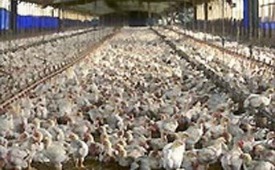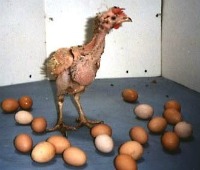Production Bred Chickens
A great number of questions we receive are health problems with 2 year old Production Bred chickens. There is much more to selecting the chicken breed you want to keep, than egg and feather colors.
There are so many beautiful breeds to choose from and choosing one you really like the looks of is one of a few important qualities.
Each spring many farm supply and feed stores offer hatchling chickens for sale. It's hard to resist chicks and keeping chickens can be very rewarding. Before you decide to buy it would be a good idea to consider the breed you want to own.
We've heard from so many, that their favorite, or one of their favorite hens is only 2 years old and not doing well. The majority are Production bred laying hens.
PRODUCTION bred chickens can be for meat production,

like the fast growing Cornish Cross. This breed was developed to put on adult sized muscles, especially leg and breast, in 6 - 8 weeks.
If Cornish Cross are allowed to live much longer than that they can develop serious health problems; one of the main ones being that their bodies can become too heavy for their feet and legs.
When purchasing this breed, you will need to get ready to butcher them when they reach 6 - 8 weeks of age. You will also need to resist keeping any of them as pets or laying hens. They will most likely be unhealthy in one way or another, and often the hens are unable to lay.
Another type of Production bred chickens are the varieties of laying hens, like Sex-Link, Comets, Stars, and Production Reds.
These breeds mature fast and lay earlier than non-Production bred hens. They were developed to lay as many eggs as possible in a short amount of time and become "laid out" earlier, too.
This type of breed is used in egg factories and often, after their first year of laying, they are sold for meat and replaced with hens just starting to lay. Long healthy life is just not in their genetic design.
We get quiet a few health questions about x-battery hens that people have rescued.

"Forced molting" when their egg production drops, hens are deprived of water and food for up to 14 days at a time in order to shock their bodies into a period of increased laying
When they reach about 2 years of age, they often develop laying and other health issues. Generally the best possible care cannot make these hens live well after 2 years of age. There are exceptions of course, but rare.
Please make sure when purchasing chickens of any age that you have enough room for them. Another source of many health questions and problems come from too many chickens in too small an area and mixing different age/sizes of chickens and chicks.
I've found through the years that young chickens do best when raised with other small chicks. An exception would be when a hen from your flock raises her own chicks within the flock.
Researching Dual Purpose breeds and Heritage breeds, should help you make the best choice of which breed or breeds to keep. Wikipedia is an excellent resource for each breed often showing adult weights and life expectancy. Hens of these breeds are more prone to broodiness, meaning they take breaks in their laying cycles wanting to incubate and hatch eggs but they generally make good mothers. Some of these breeds are poor layers in the late fall and winter, but they lay for several years, not needing to be replaced with younger hens as frequently.

Custom Search



New! Comments
Have your say about what you just read! Leave me a comment in the box below.